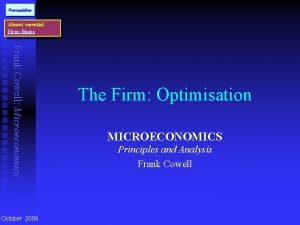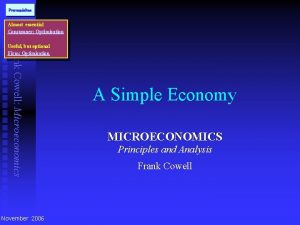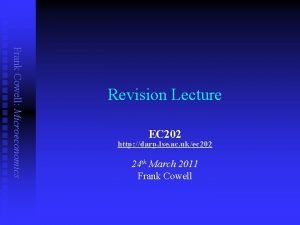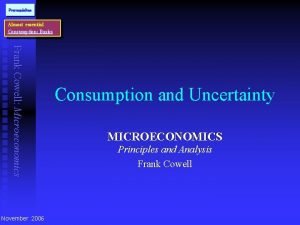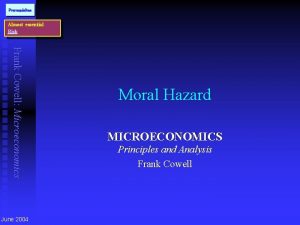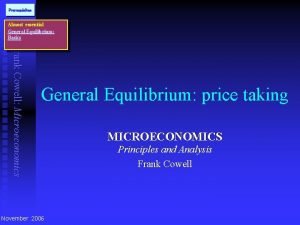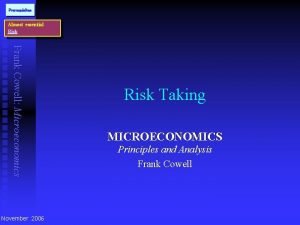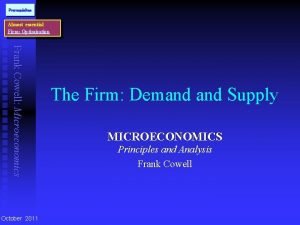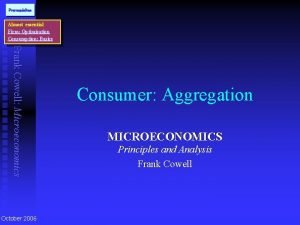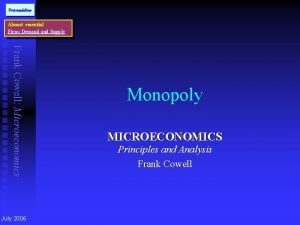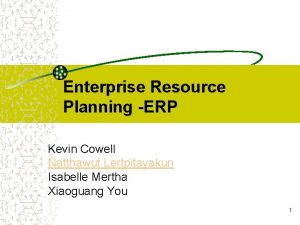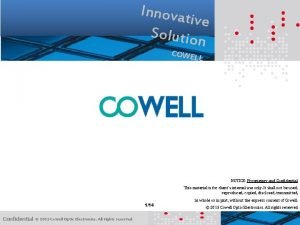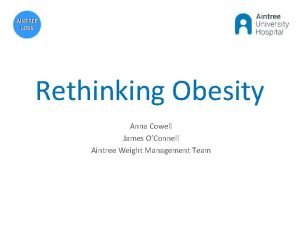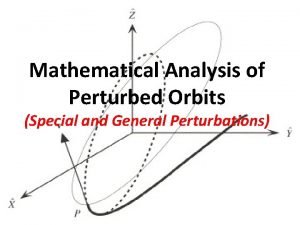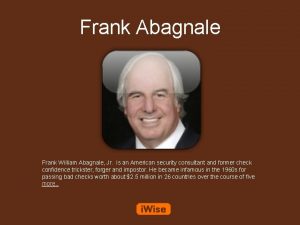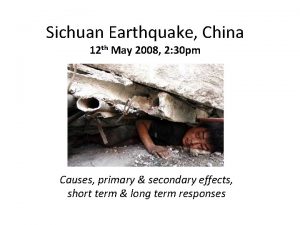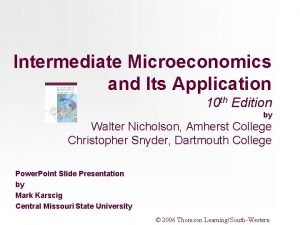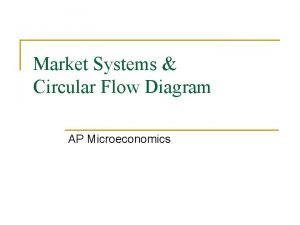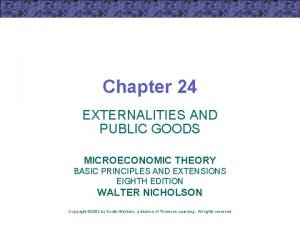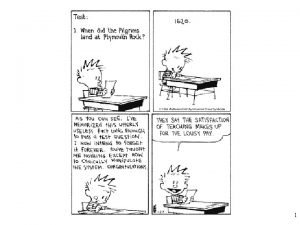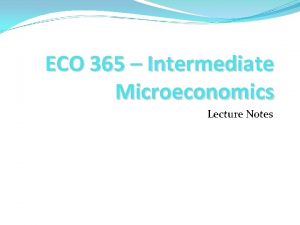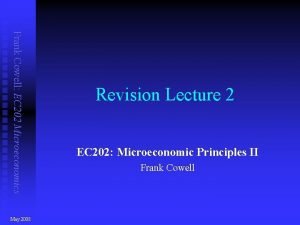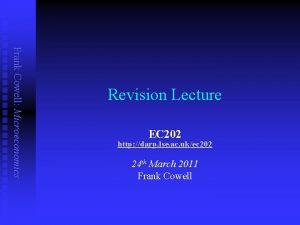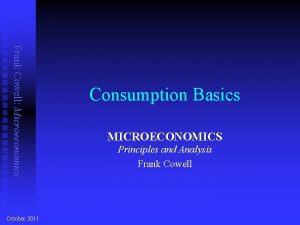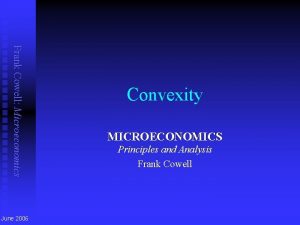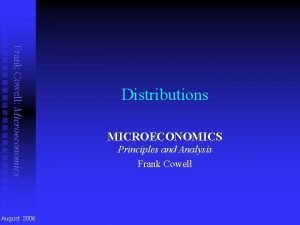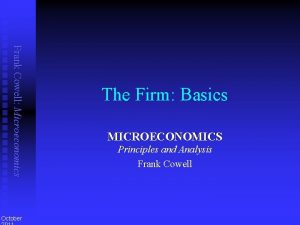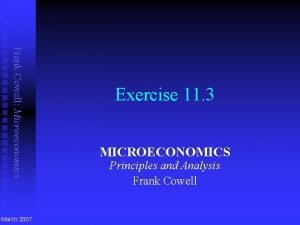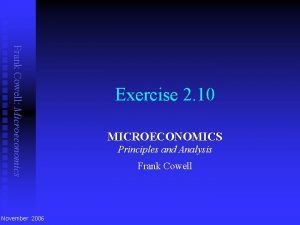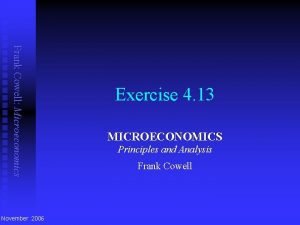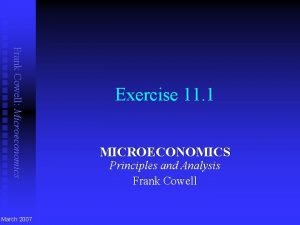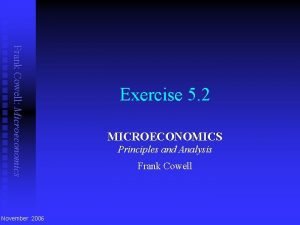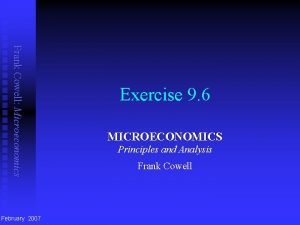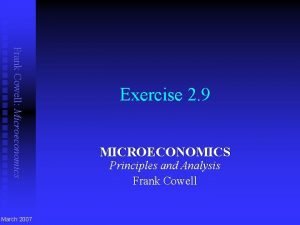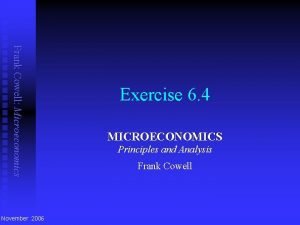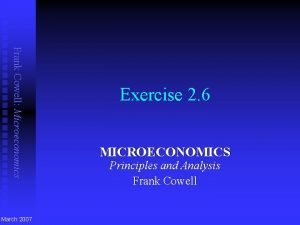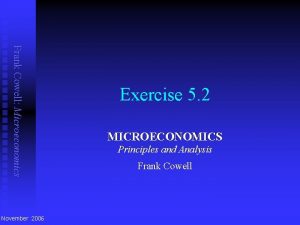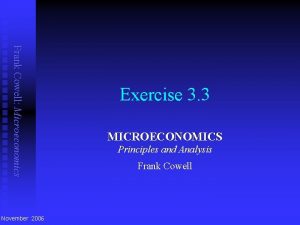Frank Cowell EC 202 Microeconomics May 2008 Revision


























- Slides: 26

Frank Cowell: EC 202 Microeconomics May 2008 Revision Lecture 1 EC 202: Microeconomic Principles II Frank Cowell

Frank Cowell: EC 202 Microeconomics Objectives of the lecture n n n A look back at Term 1 Introduction to exam preparation Reference materials used (1) u u u n exam papers (and outline answers) 2003 1(c) 2004 1(c) 2005 1(a) 2006 1(a) 2007 1(a) Reference materials used (2) u u u Cf. D presentations 2. 9 related to past exam question (. . . more to follow next week)

Frank Cowell: EC 202 Microeconomics Principles n Scope of exam material u u n Resit u u n syllabus for 2007/8 is same as 2006/7 so resit candidates from last year get the same paper as new candidates Structure and format of paper u u n what’s covered in the lectures… … is definitive for the exam follows that of last three years check out the rubric from, say, 2007 paper Mark scheme u u u 40 marks for question 1 (8 marks for each of the five parts) 20 marks for each of the other three questions multipart questions: except where it’s obvious, roughly equal marks across parts

Frank Cowell: EC 202 Microeconomics Question Style – three types n 1 Principles u u n 2 Model solving u u n a standard framework you just turn the wheels 3 Model building u u n reason on standard results and arguments can use verbal and/or mathematical reasoning usually get guidance in the question longer question sometimes easier? Examples from past question 1 One type not necessarily “easier” or “harder” than another u u u get you to display different skills part A (question 1) usually gets you to do both types 1 and 2 type 3 usually only in parts B and C of paper

Frank Cowell: EC 202 Microeconomics 2004 1(c) n n Straightforward “principles” question Just say what you need to say

Frank Cowell: EC 202 Microeconomics 2005 1(a) n n n Straight “principles” Note contrast between firm and consumer Be sure to give your reasons

Frank Cowell: EC 202 Microeconomics 2006 1(a) n n Principles again But format of question gives you a hint… …write out decomposition formula Then read off results

Frank Cowell: EC 202 Microeconomics 2003 1(c) n n A model-solving question (i) just set E(r) = 0 and twiddle (ii) check what happens to E if you change r (iii) draw diagram and reason

Frank Cowell: EC 202 Microeconomics 2007 1(a) – question and approach n n n A “hybrid” question Mainly modelsolving But there’s an important principle will a solution even exist? What’s the solution to the monopolist’s problem? Approach: u u Find the expression for profits Then try to maximise…

Frank Cowell: EC 202 Microeconomics 2007 1(a) – main answer n n To get profits we need demand function You could just jump to last line Now write down profit expression Note wording in last line

Frank Cowell: EC 202 Microeconomics 2007 1(a) – finishing off answer n n Use knowledge of basic principles Effectively the competitive case No solution! (we covered this in lectures)

Frank Cowell: EC 202 Microeconomics Long questions n Let’s look at an example u u u n Illustrates type 2 question u u n taken from exercise in the book but of “exam type” difficulty covered in Cf. D Ex 2. 9 is mainly model solving next week: look at model building Look out for tips u u Use simple principles to give you a shortcut to the answer Use pictures where they help

Frank Cowell: EC 202 Microeconomics Ex 2. 9(1): Question n n purpose: demonstrate relationship between short and long run method: Lagrangean approach to cost minimisation. First part can be solved by a “trick”

Frank Cowell: EC 202 Microeconomics Ex 2. 9(1): Long-run costs n Production function is homogeneous of degree 1 u u u n CRTS implies constant average cost u u u n increase all inputs by a factor t > 0 (i. e. z → tz)… …and output increases by the same factor (i. e. q → tq) constant returns to scale in the long run C(w, q) / q = A (a constant) so C(w, q) = Aq differentiating: Cq(w, q) = A So LRMC = LRAC = constant u Their graphs will be an identical straight line

Frank Cowell: EC 202 Microeconomics Ex 2. 9(2): Question method: n Standard Lagrangean approach

Frank Cowell: EC 202 Microeconomics Ex 2. 9(2): short-run Lagrangean n In the short run amount of good 3 is fixed u z 3 = `z 3 n Could write the Lagrangean as n But it is more convenient to transform the problem thus n where

Frank Cowell: EC 202 Microeconomics Ex 2. 9(2): Isoquants n Sketch the isoquant map z 2 z 1 n n Isoquants do not touch the axes So maximum problem must have an interior solution

Frank Cowell: EC 202 Microeconomics Ex 2. 9(2): short-run FOCs n Differentiating Lagrangean, the FOCS are n This implies n To find conditional demand function must solve for l u u use the above equations… …and the production function

Frank Cowell: EC 202 Microeconomics Ex 2. 9(2): short-run FOCs (more) n Using FOCs and the production function: n This implies u n where This will give us the short-run cost function

Frank Cowell: EC 202 Microeconomics Ex 2. 9(2): short-run costs n By definition, short-run costs are: n This becomes n Substituting for k: n From this we get u SRAC: u SRMC:

Frank Cowell: EC 202 Microeconomics Ex 2. 9(2): short-run MC and AC marginal cost average cost q

Frank Cowell: EC 202 Microeconomics Ex 2. 9(3): Question method: n Draw the standard supply-curve diagram n Manipulate the relationship p = MC

Frank Cowell: EC 202 Microeconomics Ex 2. 9(3): short-run supply curve §average cost curve §marginal cost curve p §minimum average cost §supply curve p q q

Frank Cowell: EC 202 Microeconomics Ex 2. 9(3): short-run supply elasticity n Use the expression for marginal cost: Set p = MC for p ≥ p Rearrange to get supply curve n Differentiate last line to get supply elasticity n n

Frank Cowell: EC 202 Microeconomics Ex 2. 9: Points to remember n n n Exploit CRTS to give you easy results Try transforming the Lagrangean to make it easier to manipulate Use MC curve to derive supply curve

Frank Cowell: EC 202 Microeconomics Next time n n Think more about method for long questions Look at a few Cf. D u u n n 4. 12, 4. 13 5. 1 7. 8 9. 6 See how they illustrate method Connect these to past exam questions
 Frank cowell
Frank cowell Frank cowell microeconomics
Frank cowell microeconomics Cowell microeconomics
Cowell microeconomics Cowell microeconomics
Cowell microeconomics Cowell microeconomics
Cowell microeconomics Cowell microeconomics
Cowell microeconomics Cowell microeconomics
Cowell microeconomics Frank cowell
Frank cowell New bill
New bill Frank cowell
Frank cowell 2008 2008
2008 2008 Passive progressive
Passive progressive Kevin cowell
Kevin cowell Cowell china
Cowell china Aintree loss criteria
Aintree loss criteria Cowell's method
Cowell's method Frank william abagnale jr
Frank william abagnale jr 12th may 2008
12th may 2008 Objectives of microeconomics
Objectives of microeconomics Uses of microeconomics
Uses of microeconomics Intermediate microeconomics lecture notes
Intermediate microeconomics lecture notes Circulair flow marketing
Circulair flow marketing Externalities and public goods microeconomics
Externalities and public goods microeconomics Micro economics examples
Micro economics examples Ap microeconomics unit 1 basic economic concepts
Ap microeconomics unit 1 basic economic concepts Example of macroeconomics
Example of macroeconomics Intermediate microeconomics notes
Intermediate microeconomics notes
